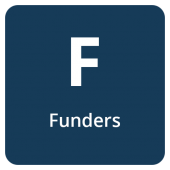Where does the money come from?
Sources includes how local wellness funds find the fiscal resources to operate, the nature or type of these resources, and how they are often combined or aligned to support the collaborative effort.
For years, multisectoral partnerships have relied heavily on “short term, often insecure financing mechanisms such as grants, contracts, and prizes” to support health and wellbeing in their communities.”¹ In an effort to minimize the dependence on these mechanisms, communities around the country are finding innovative ways to blend, braid, or align fiscal resources to more sustainably support population health initiatives using the concept of a local wellness fund.²
Local wellness funds are mechanisms for bringing funding sources together. A wellness fund’s strength lies in its ability to pool or link diverse funding streams, which promotes sustainability and allows the fund to invest in larger, historically underfunded projects. Wellness-fund-supported projects can continue even if one source cannot be sustained or becomes unavailable.
To learn more about each element, select the name of the element.
There are many potential sources of funds that local wellness funds might combine, or pool to finance or pay for their initiatives. These include:
- Community banks
- Direct appropriations from state or local funds including tax revenue
- Flexible federal and state funding streams
- Medicare, Medicaid, Children’s Health Insurance Program
- Health plans or insurers
- Hospitals or health systems, including community benefit obligations
- Individual donors
- Philanthropic grants
- Private sector investments from businesses
- Reinvestment from shared savings incentives
One organizing framework of the elements that comprise sources are included in Table 1.
Table 1: Elements of Sources
(Where is money coming from?)
- Public sector (Federal, state and local government)
- Private Sector
- Health Care Sector
- Philanthropic and nonprofit sector
- Other sectors (nontraditional)
- Bonds
- Catalytic Capital
- Dedicated Public Revenues (taxes)
- Donations
- Earned Income
- Grants
- Health Care Payment Models
- Impact Investing
- Loans
- Other public appropriations and mandates
- Savings capture and reinvestment
- Other Innovative models
Blending
Bringing together multiple funding sources into one funding stream. Blending requires unrestricted, flexible sources that do not have to be tracked back to the original source through evaluation and reporting.
Braiding
Managing multiple funding streams to address a common objective that tracking, accounting, and reporting back to their original source are required. “Expenses, management data, performance measures, and demographic and other reporting requirements can be tracked and attributed to the original funding streams.”⁴
Aligning
Facilitating and managing separate streams of funding that may be used to address multiple objectives. These funds are never pooled and are tracked and accounted for separately.
- Public Sector (Federal, state and local government)
- Private Sector
- Health Care Sector
- Philanthropic and nonprofit
- Other sectors (nontraditional)
- Bonds
- Catalytic Capital
- Dedicated Public Revenues (taxes)
- Donations
- Earned Income
- Grants
- Health Care Payment Models
- Impact Investing
- Loans
- Other public appropriations and mandates
- Savings capture and reinvestment
- Other Innovative models
Bringing together multiple funding sources into one funding stream. Blending requires unrestricted, flexible sources that do not have to be tracked back to the original source through evaluation and reporting.
Braiding
Managing multiple funding streams to address a common objective that tracking, accounting, and reporting back to their original source are required. “Expenses, management data, performance measures, and demographic and other reporting requirements can be tracked and attributed to the original funding streams.”⁴
Aligning
Facilitating and managing separate streams of funding that may be used to address multiple objectives. These funds are never pooled and are tracked and accounted for separately.
Identifying sources can be difficult, particularly when a local wellness fund is just getting started. “Mapping the money in the system” is a critical first step in understanding the funding landscape. Bringing together a diverse mix of stakeholders from different sectors will help a fund identify a wider array of potential sources. Maps can be revisited and updated regularly by both new and existing wellness funds regardless of their age.
There is no one right way to start a local wellness fund. Some wellness funds begin with a single source. Others may have multiple sources.⁵ While there is no one-size-fits-all approach, there are some strategies than can make getting started easier. Securing catalytic capital can minimize risk and help attract other investors.⁶ Seed grants from philanthropic funders also allow local wellness funds to cover start-up costs associated with establishing the fund’s structure.
Based on research conducted by the Georgia Health Policy Center as part of the Bridging for Health: Improving Community Health Through Innovations in Financing, supported by the Robert Wood Johnson Foundation, starting with multiple small donors is relatively common.”⁷ As funds mature, they may consider pursuing more innovative sources, looking for ways to reallocate existing sources and identify new sources.
There are many potential sources of funds that local wellness funds might combine, or pool to finance or pay for their initiatives. These include:
- Community banks
- Direct appropriations from state or local funds including tax revenue
- Flexible federal and state funding streams
- Medicare, Medicaid, Children’s Health Insurance Program
- Health plans or insurers
- Hospitals or health systems, including community benefit obligations
- Individual donors
- Philanthropic grants
- Private sector investments from businesses
- Reinvestment from shared savings incentives
One organizing framework of the elements that comprise sources are included in Table 1.
Identifying sources can be difficult, particularly when a local wellness fund is just getting started. “Mapping the money in the system” is a critical first step in understanding the funding landscape. Bringing together a diverse mix of stakeholders from different sectors will help a fund identify a wider array of potential sources. Maps can be revisited and updated regularly by both new and existing wellness funds regardless of their age.
There is no one right way to start a local wellness fund. Some wellness funds begin with a single source. Others may have multiple sources.⁵ While there is no one-size-fits-all approach, there are some strategies than can make getting started easier. Securing catalytic capital can minimize risk and help attract other investors.⁶ Seed grants from philanthropic funders also allow local wellness funds to cover start-up costs associated with establishing the fund’s structure.
Based on research conducted by the Georgia Health Policy Center as part of the Bridging for Health: Improving Community Health Through Innovations in Financing, supported by the Robert Wood Johnson Foundation, starting with multiple small donors is relatively common.”⁷ As funds mature, they may consider pursuing more innovative sources, looking for ways to reallocate existing sources and identify new sources.
There are many potential sources of funds that local wellness funds might combine, or pool to finance or pay for their initiatives. These include:
- Community banks
- Direct appropriations from state or local funds including tax revenue
- Flexible federal and state funding streams
- Medicare, Medicaid, Children’s Health Insurance Program
- Health plans or insurers
- Hospitals or health systems, including community benefit obligations
- Individual donors
- Philanthropic grants
- Private sector investments from businesses
- Reinvestment from shared savings incentives
One organizing framework of the elements that comprise sources are included in Table 1.
Identifying sources can be difficult, particularly when a local wellness fund is just getting started. “Mapping the money in the system” is a critical first step in understanding the funding landscape. Bringing together a diverse mix of stakeholders from different sectors will help a fund identify a wider array of potential sources. Maps can be revisited and updated regularly by both new and existing wellness funds regardless of their age.
There is no one right way to start a local wellness fund. Some wellness funds begin with a single source. Others may have multiple sources.⁵ While there is no one-size-fits-all approach, there are some strategies than can make getting started easier. Securing catalytic capital can minimize risk and help attract other investors.⁶ Seed grants from philanthropic funders also allow local wellness funds to cover start-up costs associated with establishing the fund’s structure.
Based on research conducted by the Georgia Health Policy Center as part of the Bridging for Health: Improving Community Health Through Innovations in Financing, supported by the Robert Wood Johnson Foundation, starting with multiple small donors is relatively common.”⁷ As funds mature, they may consider pursuing more innovative sources, looking for ways to reallocate existing sources and identify new sources.
There are many potential sources of funds that local wellness funds might combine, or pool to finance or pay for their initiatives. These include:
- Community banks
- Direct appropriations from state or local funds including tax revenue
- Flexible federal and state funding streams
- Medicare, Medicaid, Children’s Health Insurance Program
- Health plans or insurers
- Hospitals or health systems, including community benefit obligations
- Individual donors
- Philanthropic grants
- Private sector investments from businesses
- Reinvestment from shared savings incentives
One organizing framework of the elements that comprise sources are included in Table 1.
Table 1: Elements of Sources
Identifying sources can be difficult, particularly when a local wellness fund is just getting started. “Mapping the money in the system” is a critical first step in understanding the funding landscape. Bringing together a diverse mix of stakeholders from different sectors will help a fund identify a wider array of potential sources. Maps can be revisited and updated regularly by both new and existing wellness funds regardless of their age.
There is no one right way to start a local wellness fund. Some wellness funds begin with a single source. Others may have multiple sources.⁵ While there is no one-size-fits-all approach, there are some strategies than can make getting started easier. Securing catalytic capital can minimize risk and help attract other investors.⁶ Seed grants from philanthropic funders also allow local wellness funds to cover start-up costs associated with establishing the fund’s structure.
Based on research conducted by the Georgia Health Policy Center as part of the Bridging for Health: Improving Community Health Through Innovations in Financing, supported by the Robert Wood Johnson Foundation, starting with multiple small donors is relatively common.”⁷ As funds mature, they may consider pursuing more innovative sources, looking for ways to reallocate existing sources and identify new sources.
Those interested in creating a local wellness fund and those with existing wellness funds should:
- Ensure their local wellness fund has capital absorption capacity so they are attractive to funding sources and ready to manage funds when they come in.
- Identify sources of seed funding and catalytic capital to pay for startup costs and encourage other funders to give.
- Identify sources that can and will support the fund’s “backbone” organizational structure.
- Ensure members of the wellness fund’s leadership are well poised to identify, attract and secure a wide variety of sources.
- Align sources with uses to ensure can easily meet proposed outcomes using the funds available.
- Choose sources that are committed to advancing equity.
- Be cognizant of which sources are pursued. Leave room for those with the strongest community voice to lead the work.
- Be aware of the evaluation and reporting requirements of various sources and ensure the local wellness fund has the human and financial resources to collect, manage, evaluate, and report back to sources based on their requirements.
Options for Financing Community Prevention Efforts to Improve Health
This brief by Trust for America’s Health outlines traditional and newer sources of financing for community prevention. This resource can be used by program managers or policymakers seeking to establish, sustain, or expand community prevention initiatives to help keep their communities they serve healthy. Local wellness funds can benefit from this brief by identifying potential streams of funding to achieve goals and initiatives.
This research article in Health Affairs highlights identifies potential funding streams, specifically for Accountable Communities for Health infrastructure activities. Authors divide the funding streams into three categories: public health and social services programs, public insurance programs, and private and philanthropic initiatives. Local wellness funds can utilize the findings from this study to determine for what funding opportunities they would be strong candidates and what would best fit their programmatic needs.
This is a research report by Communities Lifting Communities, a community health improvement initiative led by the Hospital Association of Southern California. The report identifies innovative community investment strategies currently being tested and implemented across the nation, as well as partnerships and opportunities emerging in this field. Local wellness funds can benefit from the high-level overview of key findings, recommendations, and resources the report provides in identifying and developing innovative financing mechanisms.
Opportunities to Advance SDOH Efforts Through Pooled Funding
This is a research brief from the National Alliance to Impact the Social Determinants of Health (NASDOH) on advancing social determinants of health through pooled funding. NASDOH provides five recommendations for the federal government to improve community conditions for the long term. Local wellness funds who work closely with federal entities can benefit from this resource as they consider innovative financing methods, such as pooled funding.
- Kindig, D. (2015). To Launch and Sustain Local Health Outcome Trusts, Focus On ‘Backbone Resources’. Health Affairs Blog. Retrieved from https://cachi.org/uploads/resources/Kindig-Health-Trust.pdf.
- Content originally developed as part of the Bridging for Health, supported by the Robert Wood Johnson Foundation and led by the Georgia Health Policy Center.
- The Ripple Foundation, & ReThink Health (2018). Financing Workbook. Retrieved from https://rethinkhealth.org/our-work/financing-workbook/.
- Cabello, M. (2018, September 17). Braiding and Blending: Managing Multiple Funds to Improve Health. Uniting Funding Streams for Health and Social Innovation Blog Series. Retrieved from https://pfs.urban.org/pay-success/pfs-perspectives/braiding-and-blending-managing-multiple-funds-improve-health.
- Funder Forum for Accountable Health, & Georgia Health Policy Center. (2019, September). Local Wellness Funds. Retrieved from https://accountablehealth.gwu.edu/sites/accountablehealth.gwu.edu/files/Local%20Wellness%20Funds%20Brief.pdf
- Cantor, J., Powers, P., & Masters, B. (2019, July). Establishing a Local Wellness Fund: Early Lessons from the California Accountable Communities for Health Initiative. California Accountable Communities for Health Initiative. Retrieved from blueshieldcafoundation.org/sites/default/files/publications/downloadable/Establishing-a-Local-Wellness-Fund_Issue-Brief_FINAL_7-10-19.pdf.
- Minyard, K., Heberlein, E., Parker, C., Landers, G., Adimu, T., Sutton, C., Lowe, A., Albert, S., Arnold, A., Bergeron, C., Brady, K., Hamshaw, K., Kinney, S., & Morones, K. (2019, April 15). Bridging for Health: Improving Community Health through Innovations in Financing. Georgia Health Policy Center. Retrieved from ghpc.gsu.edu/download/bridging-for-health-book.







